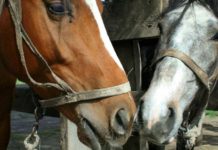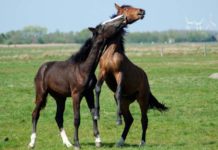
Teaching your horse to stand quietly when you ask him to whoa’ is important. Standing quietly is something the animal will have to do routinely throughout his life. Beginning with leading the animal and halting, standing is necessary for farrier work, vet work, halting under saddle, and grooming.
A horse should learn to stand right after it learns to lead. As a youngster, this command should be implanted in his brain and carried on through life. After walking forward with your horse, stop and say the word ‘whoa’, simultaneously giving a jerk of your rope. If the horse is not paying attention, he will probably walk right into you. At this point you must establish your horse’s attention upon you. Using your rope, jerk the rope until the animal moves backward. This can be accomplished by simply throwing the rope back against the animal’s neck. If this technique does not work, implement a chain across the nose of the horse, but be careful about how hard you pull on it, as it applies much more pressure. The chain should only need to be utilized a few times before the horse gains respect for the ‘whoa’. Repeat this process until the animal stands quietly for whatever length of time you require.
It is important to remember that ‘whoa’ is not multiple-choice. It has one meaning, which is to stop. don’t allow your horse to move on his own unless he is asked. Letting the animal make the decisions will only lead to further disobedience. You must establish dominance as the alpha member of this team, or your horse will fill this role for you.
Once your horse has learned to stand quietly on the lead, you can expect him to stand quietly for grooming and hoof care. Cross-tying the animal in a grooming area is the safest area to groom your animal, but ties are not an excuse for him to move side to side. Enforce your horse’s attention. Keep the lead rope attached to the halter, even while cross-tied. As you move about brushing the horse, give the rope a firm jerk and say ‘whoa’ if he moves about. Be sure to move slowly around the animal, do not spook him or unintentionally encourage him to move away from you. Standing quietly for the farrier or vet can be challenging. Even the quietest of horses can have bad associations with the vet or farrier. But this is no excuse to give up. Be sure that you are there with the animal if these professionals spook him. Continue to encourage him to stand quietly by repeating the training techniques he is familiar with. If reprimanding the animal is of no use, or the animal is endangering you, the farrier, or himself, a tranquilizer or twitch may be necessary to restrain him. It is better for the horse to have had a positive experience with some sort of medication than to continue to remember the experience filled with punishment and discomfort.
You should also expect your horse to stand quietly while mounting and during riding. When mounting your animal, keep a tighter hold of the left rein than the right, but not tight enough to encourage movement in the animal. Keeping his head bent slightly towards you will prevent him from being able to move forward quickly during mounting. If the horse does move, pull on the rein and say ‘whoa’ until the animal stands. Do not mount until he learns this. Show him that there is nothing to be afraid of. Do not punish him excessively or he will become scared of being mounting.
While riding, pulling on the reins with uneven pressure to stop your horse is always important. Pulling on both reins evenly just gives the horse something to pull back on. Using your voice command, ask the horse to stop. A horse that wants to keep moving may need a different strategy. Ask the horse to move forward at a canter. Encourage multiple circles at this gait for a few minutes. If the horse still does not want to stop, reverse and ask him to lope or canter again. Ask him for some more difficult maneuvers, flexions, etc. Ask for the halt again. Your horse should be ready for a break and willing to stand. Keep using this type of reverse psychology every time the animal tries to move forward. Eventually, the horse will stand for extended periods. This is preferred to difficult work.
Be sure that you are not asking something that is unfair of your horse. If he has been cooped up for days, he may have too much energy to focus or stand still. This is not his fault. He may not be quiet again until after a few days of work, depending on your horse’s specific energy level.





